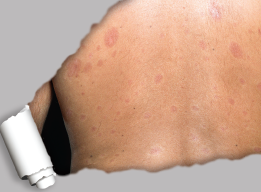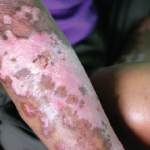
Skin plaques in systemic sclerosis.
SPL / Science Source
What happens when systemic sclerosis (SSc) overlaps with other systemic autoimmune rheumatic diseases? Patients with either diffuse cutaneous or limited cutaneous SSc sometimes develop systemic lupus erythematosus (SLE) as well. A new, large cohort study published in the Journal of Rheumatology reveals details on the epidemiology, clinical signs and survival data of SSc-SLE overlap syndrome.1
“Little is known on this group of patients, and it is important to shed light on their prevalence and characteristics,” says Sindhu R. Johnson, MD, PhD, director of the Toronto Scleroderma Project at the University of Toronto, Canada, and a study co-author. “The field of overlap syndromes has been challenging for clinicians. There is a lack of understanding and knowledge about what overlap means in terms of potential complications and prognosis. We do not have clearly specified diagnostic criteria or classification criteria to systemically identify these people.”
Past evidence shows SSc-SLE overlap patients more frequently present with Raynaud’s phenomenon and such complications as discoid lupus, lupus nephritis, pancreatitis, avascular bone necrosis and shrinking lung syndrome.2-6 Evidence also shows anti-U1RNP antibodies are more frequent in SSc-SLE overlap syndrome, and this study revealed more important serological markers.7 Anti-RNP or anti-U1RNP may be useful screening tests for SSc overlap syndromes, says Dr. Johnson.
Young, Female, Asian
The study’s cohort included subjects from the Toronto Scleroderma Program (a network of three academic hospitals) who fulfilled the ACR/European League Against Rheumatism (EULAR) classification criteria for SSc and/or the ACR classification criteria for SLE.8-10 The primary outcome was time from diagnosis to all-cause mortality. Patients were followed every 6–12 months using a standardized protocol. The study period ran from 1970–2017.
Out of 1,252 subjects, the researchers identified 1,116 with SSc only and 86 with SSc-SLE overlap syndrome, a prevalence of 6.8%. The overlap syndrome subjects were 92% female and 10 years younger at diagnosis than SSc patients who did not have SLE (a mean age of 37.9 vs. 47.9 years). In addition, compared with SSc patients without SLE, overlap syndrome patients in the study were more commonly of East Asian or South Asian ancestry.
Compared with SSc patients without SLE, overlap syndrome patients more frequently had lupus anticoagulant, anti-cardiolipin antibodies and pulmonary arterial hypertension (PAH). Less frequently, overlap patients had calcinosis, telangiectasia and diffuse subtype. The study found no significant differences between the two groups when it came to the occurrence of renal crisis, interstitial lung disease (ILD) or digital ulcers.
Patients in the two groups had no significantly different occurrences of comorbidities like hypertension, diabetes, dyslipidemia, cancer, stroke or atrial fibrillation. All of the SSc-SLE overlap syndrome patients had anti-dsDNA or anti-Sm antibodies.
No survival data had been reported for SSc-SLE overlap syndrome before this study. There were 432 deaths recorded during the follow-up, including 411 subjects with SSc alone and 21 with SSc-SLE overlap. Overlap syndrome patients had a better, but not statistically significant, difference in mean survival time: 26.1 years compared with 22.4 years for patients with SSc alone. Overlapping SLE neither increases the risk of, nor offers any protective effect against, mortality, the study found.
Not So Uncommon

Dr. Johnson
The study’s estimated SSc-SLE overlap syndrome prevalence of 6.8% suggests the condition is not uncommon in SSc, the co-authors write. It may be a conservative estimate, because all patients included in the study were required to fulfill the classification criteria for both diseases. Cases of mild or early, physician-diagnosed disease that did not fulfill all the criteria may have been missed, they write.11,12
More research on the specific characteristics of SSc-SLE overlap syndrome will help rheumatologists more accurately classify these patients, says Dr. Johnson.
“As long as our understanding of this group of patients evolves, our ability to identify them early will continue to improve,” she says. “The new classification criteria for SLE being developed with the support of ACR and EULAR may assist with the earlier classification of people with SLE. The ACR/EULAR classification criteria for SSc has been shown to classify those with SSc earlier.”
Survival bias may have affected the study’s results, because some SSc patients may have died before they developed SLE, the co-authors write. On the flip side, SLE characteristics may bring a patient’s SSc diagnosis to light earlier, a possibility noted by the younger age and less frequent sclerodactyly seen in the overlap group. The co-authors also note that the small proportion of overlap patients with SSc antibodies may be low, because measurement of these antibodies was not readily available in the early years of the study period.
This large, well-characterized study, with its robust mortality data, is an important way to provide new insights and potential guidance for clinicians who encounter patients with suspected SSc-SLE overlap, says Dr. Johnson.
“SSc-SLE overlap subjects less frequently have cutaneous manifestations of SSc, [but] clinicians should still screen for serious internal manifestations, notably interstitial lung disease, pulmonary arterial hypertension and scleroderma renal crisis. [Enthusiasm for] these findings should be tempered; they require external validation,” she says.
Based on their study’s findings, the co-authors conclude SSc-SLE overlap syndrome patients are typically female and younger at diagnosis, and less frequently feature cutaneous SSc manifestations. They recommend rheumatologists regularly monitor overlap syndrome patients for serious SSc complications, such as PAH, ILD, renal crisis and digital ulcers.
Susan Bernstein is a freelance medical journalist based in Atlanta.
References
- Alharbi S, Ahmad Z, Bookman AA, et al. Epidemiology and survival of systemic sclerosis-systemic lupus erythematosus overlap syndrome. J Rheumatol. 2018 Oct;45(10):1406–1410.
- Foocharoen C, Netwijitpan S, Mahakkanukrauh A, et al. Clinical characteristics of scleroderma overlap syndromes: Comparisons with pure scleroderma. Int J Rheum Dis. 2016 Sep;19(9):913–923.
- Umbert P, Winkelmann RK. Concurrent localized scleroderma and discoid lupus erythematosus. Cutaneous ‘mixed’ or ‘overlap’ syndrome. Arch Dermatol. 1978 Oct;114(10):1473–1478.
- Suzuki Y, Okamoto H, Koizumi K, et al. A case of severe acute pancreatitis, in overlap syndrome of systemic sclerosis and systemic lupus erythematosus, successfully treated with plasmapheresis. Mod Rheumatol. 2006;16(3):172–175.
- Cavallasca JA, Laborde HA, Aranjo MB, et al. Multiple avascular necrosis in a patient with systemic lupus erythematosus/systemic sclerosis overlap syndrome. Clin Rheumatol. 2005 Aug;24(4):406–408.
- Guleria VS, Singh PK, Saxena P, et al. Shrinking lung syndrome in systemic lupus erythematosus-scleroderma overlap. Lung India. 2014 Oct;31(4):407–409.
- Pakodzi A, Nihtyanova S, Moinzadeh P, et al. Clinical and serological hallmarks of systemic sclerosis overlap syndromes. J Rheumatol. 2011 Nov;38(11):2406–2409.
- van den Hoogen F, Khanna D, Fransen J, et al. 2013 Classification criteria for systemic sclerosis: An American College of Rheumatology/European League Against Rheumatism collaborative initiative. Ann Rheum Dis. 2013 Nov;72(11):1747–1755.
- Tan EM, Cohen AS, Fries JF, et al. The 1982 revised criteria for the classification of systemic lupus erythematosus. Arthritis Rheum. 1982 Nov;25(11):1271–1277.
- Hochberg MC. Updating the American College of Rheumatology revised criteria for the classification of systemic lupus erythematosus. Arthritis Rheum. 1997 Sep;
40(9):1725. - Johnson SR, Khanna D, Allanore Y, et al. Systemic sclerosis trial design moving forward. J Scleroderma Relat Disord. 2016 May–Aug;1(2):177–180.
- Johnson SR. New ACR EULAR guidelines for systemic sclerosis classification. Curr Rheumatol Rep. 2015 May;17(5):32.

